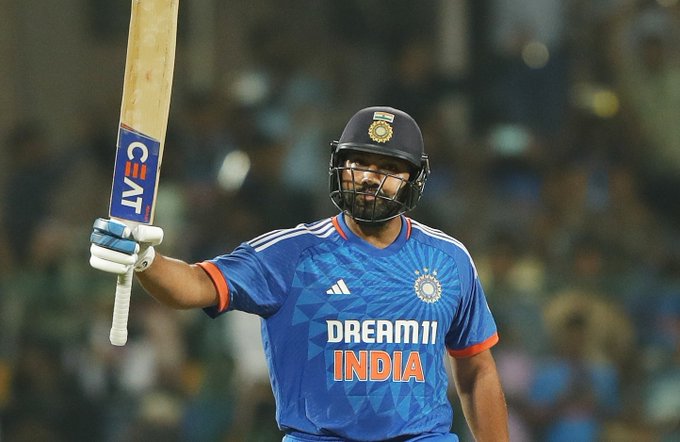
It has been nearly 17 years since Rohit Sharma made his debut for India in Twenty20 international. Like it happens when one is browsing memories of many wonderful cricketers who have graced the game, the mind makes time seem to either speed or crawl, depending on what comes up. Surely, when one looks back at his Twenty 20 international debut, it seems like it was yesterday.
He was 20 when he walked in to bat for the first time in a Twenty20 international. It was the Super Eights contest against England in the ICC World Twenty20 2007 at the Kingsmead Cricket Ground in Durban that he replaced Dinesh Karthik in the XI. He had not been in the mix in the first four games in the ICC World Twenty20 2007.
India’s first league game against Scotland was washed out and it won its clash with Pakistan, famously via the bowl out. Then in the two Super Eights matches that followed against New Zealand in Cape Town and England in Durban, he did not find a berth in the XI. He was not needed to bat as India beat England comfortably.
He watched a Yuvraj Singh special from the team bunker – now more popularly called the dugout. And it was only in the next match against home side South Africa that he walked in to bat for the first time in a T20 international. It was a challenging situation in which Rohit Sharma took guard, with the scoreboard reading 33 for three.
🚨Team India Commences Training in New York Amid Security Preparations for IND vs PAK.#INDvPAK #TeamIndia #T20WorldCup #NassauCounty #LoneWolfAttack @CricSubhayan @Wowmomo4u pic.twitter.com/EIMJYdCl2T
— RevSportz (@RevSportz) May 30, 2024
Shaun Pollock exploited the conditions to remove Gautam Gambhir and Dinesh Karthik in the fifth over. Makhaya Ntini followed that up by enticing Virender Sehwag to nick a catch to wicket-keeper Mark Boucher. It was a veritable trial by fire for Rohit Sharma, but he coped by playing and missing a few times.
His first boundary hit was not the best-timed stroke and he had fought to make 13 off 16 balls when he lost Robin Uthappa’s company in the 11th over. India was down in the dumps at 61 for four. But with skipper Mahendra Singh Dhoni for company, he shared an 85-run stand that let the Indian bowlers have a moderate score to defend.
He finished with an unbeaten 50 as India powered to 153 for five. By the time he left the crease in the final over, Dhoni had seen enough of Rohit Sharma’s creativity and aggression, his use of feet, his confidence, his temperament and his stomach for a fight. The captain knew that the team had found a high quality player it could bank on.
The extra time that he seemed to have to play shots against fast bowlers was a standout feature even in his maiden innings. An acute awareness of the field that skipper Graeme Smith and the bowlers set for him enabled him to find the gaps on either side of the wicket. But above all, his game sense was evident to everyone in Kingsmead and beyond.
Rohit Sharma was not done with stamping his imprint on the match. He engineered the dangerous Justin Kemp’s run out dismissal with spectacular fielding. He raced in from the 30-yard circle to swoop on the ball and, when being airborne, he flicked the ball on to the wicket to catch Kemp short of the crease. It was a moment that would be etched in the minds for a long time.
There was more evidence that India had blooded a quality cricketer. After the customary press conference conducted by ICC, some of the Indian media wanted Rohit Sharma to answer a few questions in Hindi. Placing an arm around Rohit Sharma’s shoulder, Dhoni broke into a wide smile and said: “After today, Rohit does not need the media as much as the media needs him.”
A few days later, Harbhajan Singh waxed eloquent about Rohit Sharma. “Look at how Rohit Sharma played against South Africa. It was brilliant that he could play so well under pressure against the favourite. It is great to see the youngsters take up responsibility and if they keep playing to potential, India has a great chance to be the best side in the world,” he said.
Even in the final against Pakistan, while everyone recalls Gautam Gambhir’s 75, Rohit Sharma made an unbeaten 30 off 16 deliveries to help India cross the 150-mark. In fact, he accounted for 24 of the 27 runs that India picked up in the last two overs. Had it not been for his never-say-die approach against Yasir Arafat and Sohail Tanvir, India would not have enough runs to defend.
Of course, Rohit Sharma has made led the team in 115 of his 472 appearances and has played some most memorable innings, including 48 centuries and 101 half-centuries. But it will be a good guess that he will remember the first of those knocks, dating back nearly 17 years, with some fondness.
Also Read: Parag’s browsing history in the public interest? You must be joking



